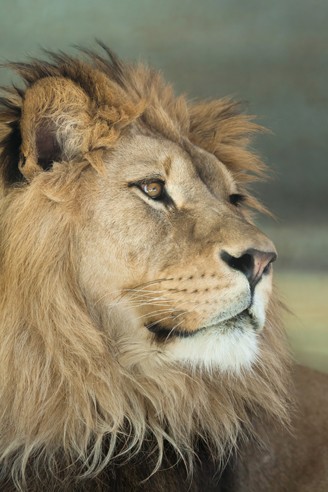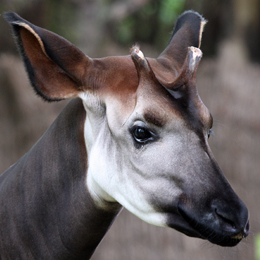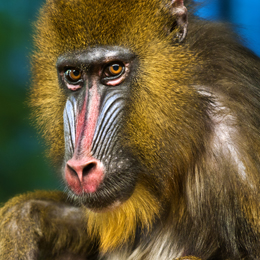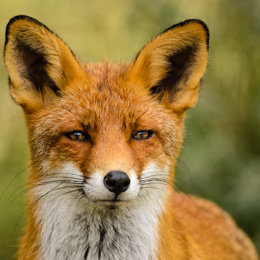Introduction
The male lion is often referred to as the King of the Jungle. Any creature wandering in lion territory has to stay extremely alert. In lion territory, predators are at a greater risk of getting killed than their potential prey. In the dry savannas and deciduous forests, where food is scarce, lions often kill other predators to reduce the predator competition in its range.
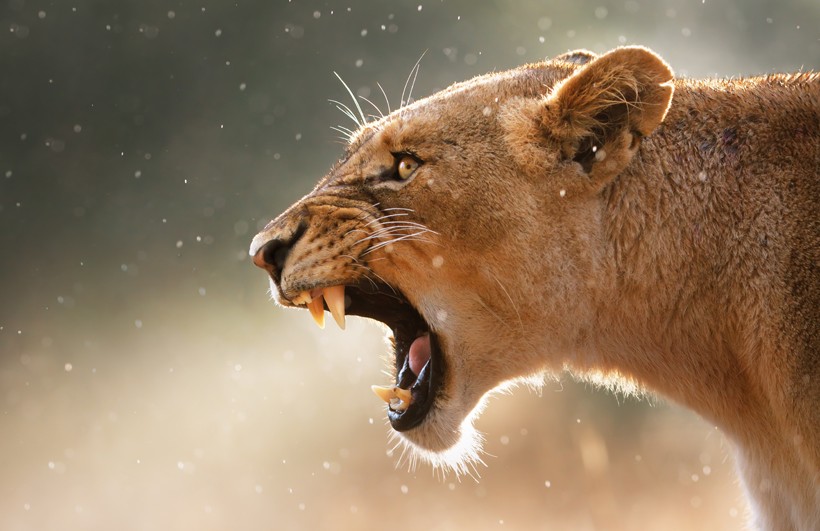
A lion’s roar can be heard at a distance of several kilometers.
?
Image credits: Johan Swanepoel/Shutterstock
The name “Lion”, originates from Latin “Leo” and Ancient Greek “Leon”. The scientific name of this species is Panthera leo. The lion and its close relatives tigers, leopards, cheetahs, jaguars and other big cats constitute the genus Panthera. The males and females of Panthera leo are easily distinguishable. In fact, no other species in the genus Panthera displays such clearly visible sexual dimorphism. The male is clearly larger and heavier than the female. The adult male lion has a mane of long dark hair around its neck, which is completely absent in females. Both males and females can live for up to 15 years in the wild and in captivity, their lifespan can be much longer. However, males have a difficult lifestyle. As they are frequently challenged by rival males, most wild males don’t make it pass their 10th birthday. As the male becomes older, it is often defeated or killed by young nomad males looking for a pride.
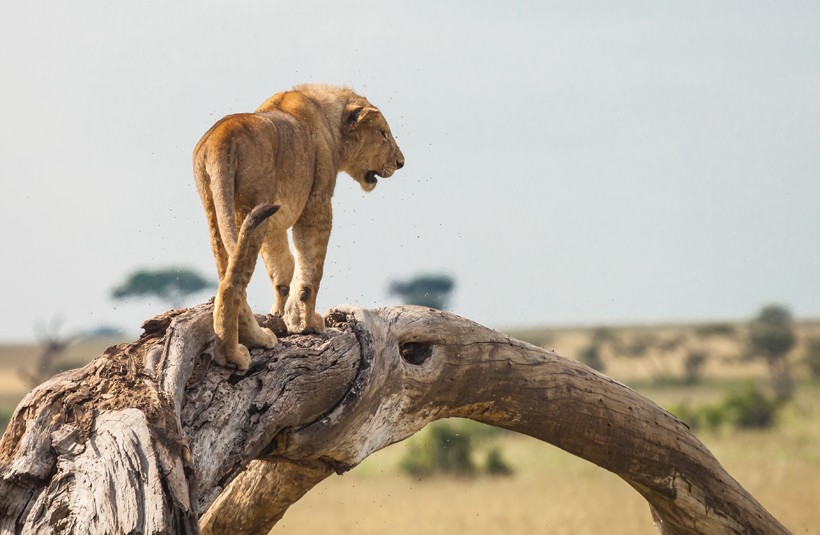
Unlike other big cats, lions display clearly visible sexual dimorphism.
?
Image credits: kongsak sumano/Shutterstock
The average weight of males ranges from 140 to 250 kg whereas females weigh only 120 to 175kg. Lions use their strong sense of smell, vision and hearing to spot their prey. Their eyes are six times more sensitive to light than that of humans, allowing them to see clearly even in the dark. Their senses of smell and hearing are also equally efficient. A lion can smell a carcass from miles. This allows the predator to scavenge successfully when prey is scarce during dry seasons.
Subspecies, Distribution and Characteristics
The species Panthera Leo evolved between 1 million to 800,000 years ago and several subspecies of the lion have occurred over the course of time. Here are 8 of the most recent subspecies of the lion.
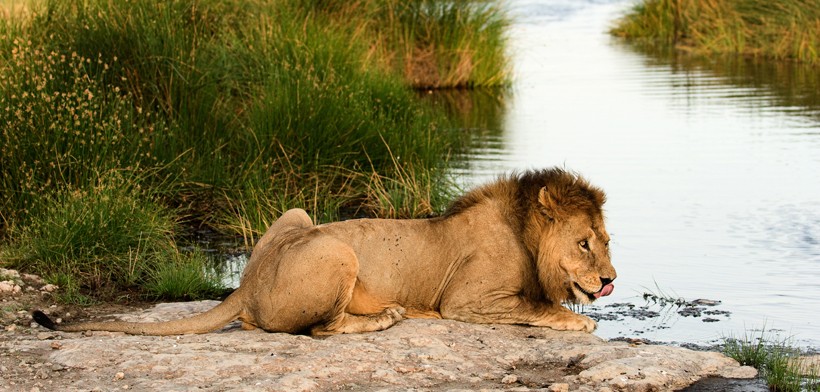
East African Lion or Masai Lion
?
Image credits: Sergey Uryadnikov/Shutterstock
- East African Lion or Masai Lion (Panthera leo nubica)
The Masai Lion is also mentioned as the East African Lion as they occur in the eastern parts of Africa. Male Masai lions are large. Their length can be up to 2 to 3 meters including the tail. Males weigh between 150 and 200 kg and females weigh up to 165kg on average. Male Masai lions, known for their lush manes, are living at higher altitudes above 2600 ft in dry, scant lowlands. Masai lions are distributed over a vast range from Ethiopia and Kenya to Tanzania and Mozambique.
Out of all Masai lions, the scanty maned Lions of Tsavo have a fierce reputation of being man-eaters. These lions are highly aggressive in nature, especially due to the harsh climates and low availability of prey animals in the dry lowlands of East Africa. In 1898, more than 120 railway workers were hunted down by just two Tsavo lions. The lions regularly attacked and killed workers at the Kenya-Uganda Railway line until finally Colonel John Patterson killed both lions. The two Tsavo Brothers are still on display at the Field Museum of Natural History in Chicago.
The Masai Lion is also mentioned as the East African Lion as they occur in the eastern parts of Africa. Male Masai lions are large. Their length can be up to 2 to 3 meters including the tail. Males weigh between 150 and 200 kg and females weigh up to 165kg on average. Male Masai lions, known for their lush manes, are living at higher altitudes above 2600 ft in dry, scant lowlands. Masai lions are distributed over a vast range from Ethiopia and Kenya to Tanzania and Mozambique.
Out of all Masai lions, the scanty maned Lions of Tsavo have a fierce reputation of being man-eaters. These lions are highly aggressive in nature, especially due to the harsh climates and low availability of prey animals in the dry lowlands of East Africa. In 1898, more than 120 railway workers were hunted down by just two Tsavo lions. The lions regularly attacked and killed workers at the Kenya-Uganda Railway line until finally Colonel John Patterson killed both lions. The two Tsavo Brothers are still on display at the Field Museum of Natural History in Chicago.
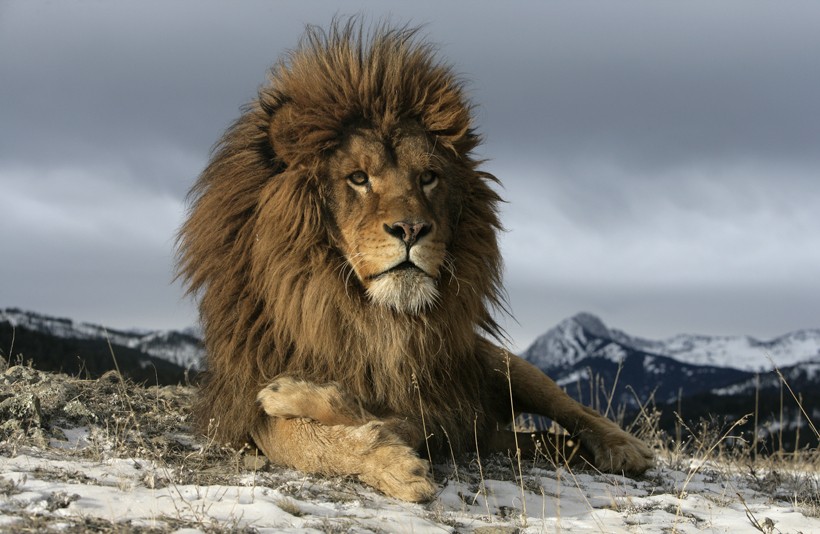
Barbary Lion
?
Image credits: Erni/Shutterstock
- Barbary Lion (Panthera leo leo)
The Barbary lion is the nominate subspecies named as Panthera leo leo This subspecies is also known as the Atlas lion, as it once inhabited the Atlas Mountains in North Africa. The Barbary lion is, unfortunately, extinct in the wild, but it was once the largest of all subspecies of lions. An adult male could weigh up to 300 kg and show a head-to-tail length of up to 2.8 meters. Excessive hunting resulted in the extinction of this subspecies. The last Atlas lion in nature was killed in the early 19th century. No sightings of wild atlas lions have been reported after 1960.
The Barbary lion is the nominate subspecies named as Panthera leo leo This subspecies is also known as the Atlas lion, as it once inhabited the Atlas Mountains in North Africa. The Barbary lion is, unfortunately, extinct in the wild, but it was once the largest of all subspecies of lions. An adult male could weigh up to 300 kg and show a head-to-tail length of up to 2.8 meters. Excessive hunting resulted in the extinction of this subspecies. The last Atlas lion in nature was killed in the early 19th century. No sightings of wild atlas lions have been reported after 1960.
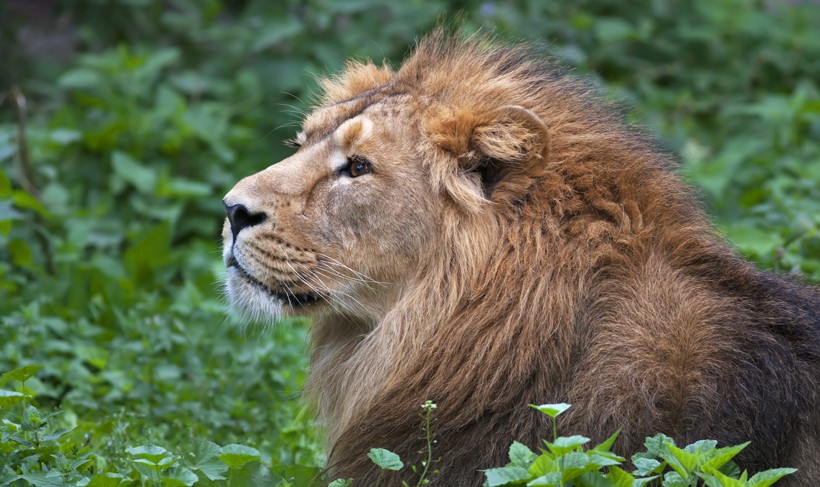
Asiatic Lion
?
Image credits: andamanec/Shutterstock
- Asiatic Lion (Panthera leo persica)
The Asiatic Lion is the closest relative to the Barbary lion and is also known as the Indian or Persian lion. This lion is the only surviving subspecies in Asia and it inhabits a small deciduous forest range in the state of Gujarat in India. Male Asiatic lions have a scanty mane and the weight ranges between 160 and 190 kg. The Gir National Park in Gujarat is the only habitat where the Asiatic lion population is still surviving. The population has increased over the last decade and new plans have been proposed about the introduction of this subspecies to different forest settings in Asia.
The Asiatic Lion is the closest relative to the Barbary lion and is also known as the Indian or Persian lion. This lion is the only surviving subspecies in Asia and it inhabits a small deciduous forest range in the state of Gujarat in India. Male Asiatic lions have a scanty mane and the weight ranges between 160 and 190 kg. The Gir National Park in Gujarat is the only habitat where the Asiatic lion population is still surviving. The population has increased over the last decade and new plans have been proposed about the introduction of this subspecies to different forest settings in Asia.
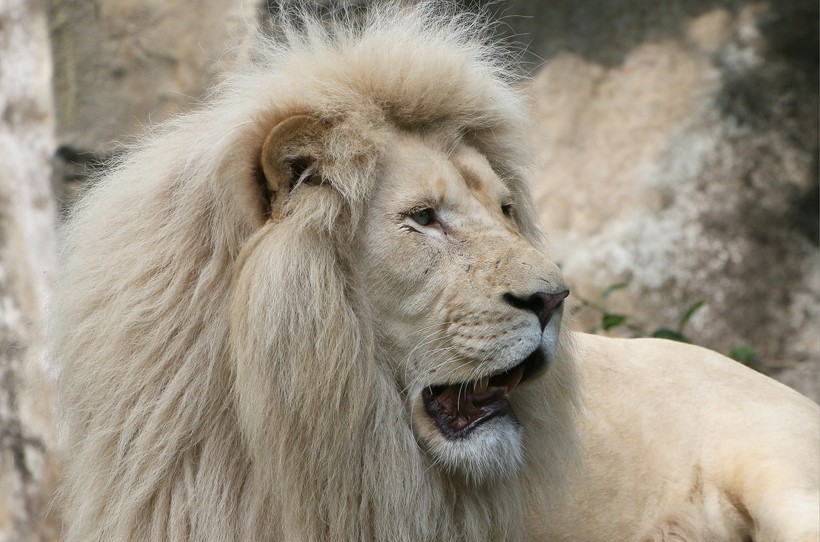
Transvaal Lion
?
Image credits: Ger Bosma Photos/Shutterstock
- Transvaal Lion (Panthera leo krugeri)
The Transvaal lion is also known as the Southeast African Lion or Kalahari Lion. This subspecies inhabits the Transvaal region and the Kruger National Park. The males of this subspecies can weigh up to 250 kg and they are known for their well-developed dark manes. A normal Transvaal lioness can sometimes give birth to white lions. This appearance is due to a disorder, called Leucism, which occurs only in this subspecies. White lions have a smaller chance of survival in the wild as they can be spotted easily by the prey. Hence, white lions are mostly found in zoos and other protected areas.
The Transvaal lion is also known as the Southeast African Lion or Kalahari Lion. This subspecies inhabits the Transvaal region and the Kruger National Park. The males of this subspecies can weigh up to 250 kg and they are known for their well-developed dark manes. A normal Transvaal lioness can sometimes give birth to white lions. This appearance is due to a disorder, called Leucism, which occurs only in this subspecies. White lions have a smaller chance of survival in the wild as they can be spotted easily by the prey. Hence, white lions are mostly found in zoos and other protected areas.
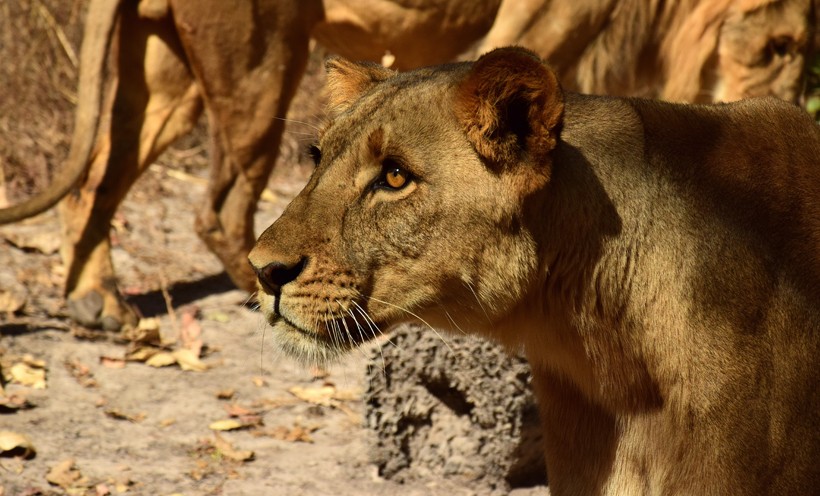
West African or Senegal lion
?
Image credits: mariusz Drabik/Shutterstock
- West African Lion (Panthera leo senegalensis)
The West African or Senegal lion is very rare throughout its range. Its range spans between Senegal and Central African Republic in the west of Africa. Compared to other subspecies, West African lions are smaller and live in smaller groups. Males of this subspecies don’t have manes and their skull size is also smaller compared to the other subspecies.
The West African or Senegal lion is very rare throughout its range. Its range spans between Senegal and Central African Republic in the west of Africa. Compared to other subspecies, West African lions are smaller and live in smaller groups. Males of this subspecies don’t have manes and their skull size is also smaller compared to the other subspecies.
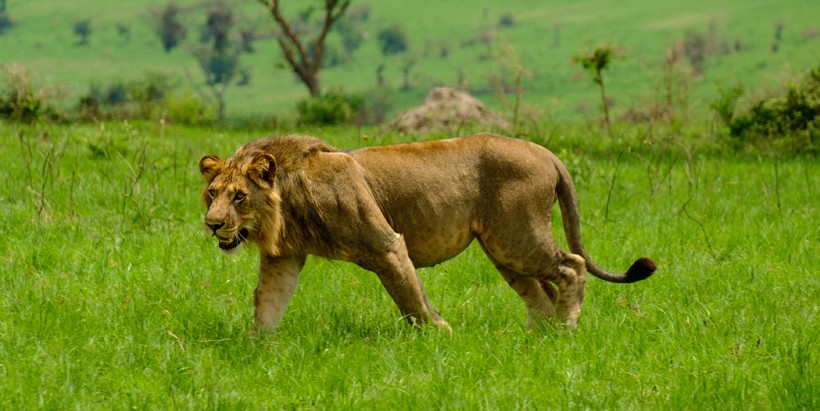
Congo Lion or Uganda Lion
?
Image credits: zampe238/Shutterstock
- Congo Lion (Panthera leo azandica)
The Congo Lion is also known as the Northeast Congo Lion or the Uganda Lion. This subspecies can be found in the Congo River basin and look quite similar to the Masai lions. They are distributed over a small range and are under tremendous threat of extinction. Latest surveys conclude that the lion is already extinct in Rwanda.
The Congo Lion is also known as the Northeast Congo Lion or the Uganda Lion. This subspecies can be found in the Congo River basin and look quite similar to the Masai lions. They are distributed over a small range and are under tremendous threat of extinction. Latest surveys conclude that the lion is already extinct in Rwanda.
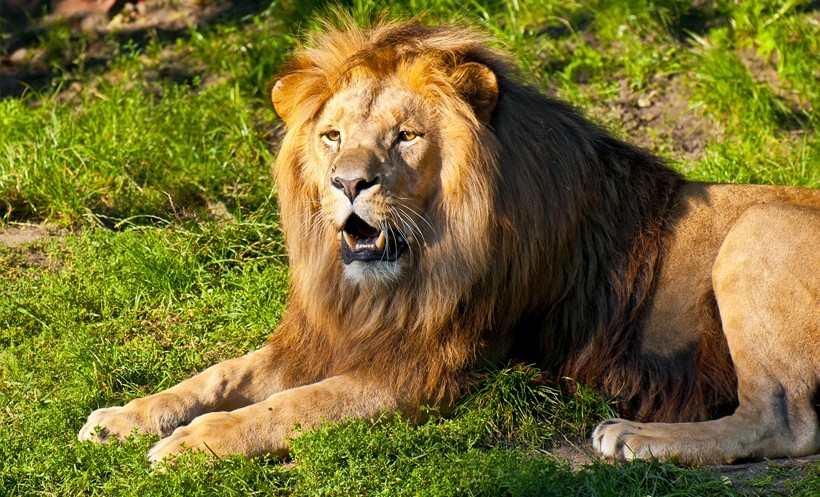
Southwestern African or Katanga lion
?
Image credits: Pablo77/Shutterstock
- Southwest African Lion (Panthera leo bleyenberghi)
The Southwestern African or the Katanga lions are found in the southwest region of Africa. Their natural range lies between Namibia, western Zambia, western Zimbabwe, northern Botswana, Zaire and Angola. The weight ranges from 140 to 240 kg for adult males and 100 to 170 kg for their female counterpart.
- Ethiopian Lion (Panthera leo roosevelti)
This subspecies is native to Ethiopia. They have been observed and studied in captivity but wild encounters are yet to be confirmed. This subspecies is also known as the Addis Ababa Lion or Abyssinian lion. Genetic analysis has been conducted on lions in Addis Ababa’s zoo and scientists concluded that this species is quite unique.
The Southwestern African or the Katanga lions are found in the southwest region of Africa. Their natural range lies between Namibia, western Zambia, western Zimbabwe, northern Botswana, Zaire and Angola. The weight ranges from 140 to 240 kg for adult males and 100 to 170 kg for their female counterpart.
This subspecies is native to Ethiopia. They have been observed and studied in captivity but wild encounters are yet to be confirmed. This subspecies is also known as the Addis Ababa Lion or Abyssinian lion. Genetic analysis has been conducted on lions in Addis Ababa’s zoo and scientists concluded that this species is quite unique.
Habitat, Diet and Behavior
In Africa, the lions inhabit the savannah grasslands. However, in Asia lions are found only in the dry deciduous forests located in the state of Gujarat in India. Due to the dry climate in this habitat, the lions prefer to rest in the shadow during the daytime. An average day is spent by roughly 2 hours walking, 1 hour eating and up to 18 to 20 hours of sleeping and resting.
Lions are the only cats that live in groups, which is called a pride. Being more strength full within a group, they hunt on large mammals like buffaloes and wildebeests. Therefore, lions don’t have to hunt every day. After one large kill, the pride may not hunt for the next several days.
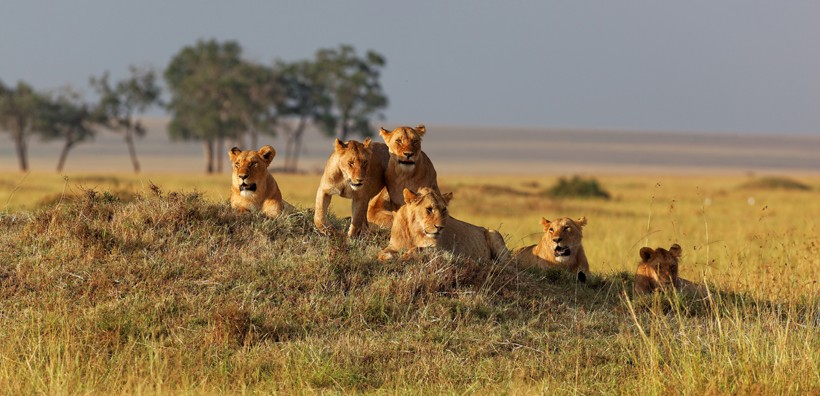
Lion pride on watch at sunset, Masai mara, Kenya, Africa
?
Image credits: GuidoAmrein, Switzerland/Shutterstock
A typical pride consists of one large male, 5 to 15 females and their cubs. Lions are highly adaptable and opportunistic. Nomad males can sometimes form coalitions to increase their chances of survival. Coalitions may contain up to 4 males. If a coalition takes over a pride, all the males have equal mating rights with the females of the pride. Coalitions are quite common among all lions except the Tsavo lion. Tsavo lion prides usually have only one dominant male in a pride. Once the male takes over a pride, he spends the day resting and looking after the cubs while the females do most of the hunting.
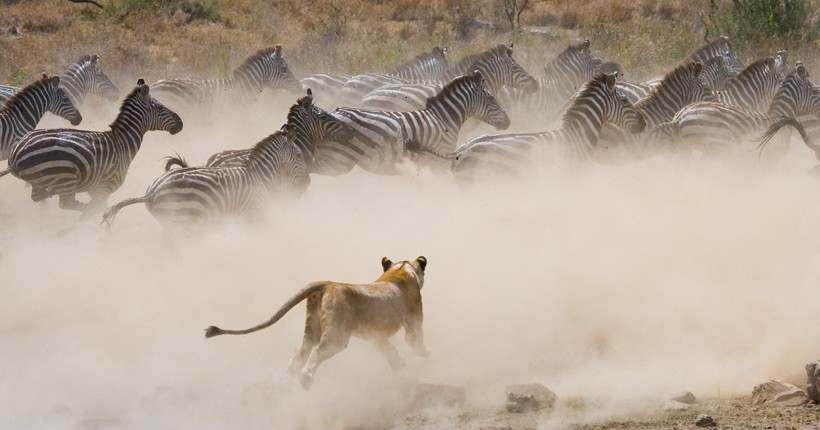
lioness attack on zebra herd
?
Image credits: GUDKOV ANDREY/Shutterstock
Within a large pride up to 10 to 15 lionesses can be seen working together, displaying extraordinary intelligence and coordination. They frequently change hunting styles depending upon the conditions of the habitat and the type of prey animal on target. Lions may be active at any time of the day but prefer to hunt during night time as the temperature is lower and their prey has low visibility in the dark; with its sharp senses, the lion clearly has the upper hand at night.
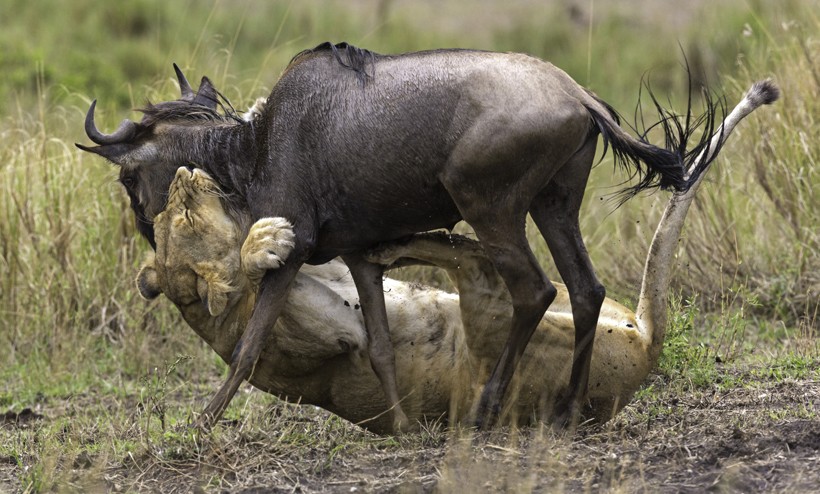
Lioness killing a wildebeest
?
Image credits: Seyms Brugger/Shutterstock
Usually, the weakest in the herd becomes the target. Babies or wounded animals are targeted first, as it saves energy and also avoids injuries for the lions. A typical hunt starts with a sneak mode. Their prey species like the wildebeests and the buffaloes are found in large herds. So, the pride stays low and tries to get closer to the herd without being detected. At a safe distance, they slowly split up and surround the herd from different positions. Each female holds her position and at the right moment, one of them chooses a target and starts the chase. Panic strikes the herd and amidst the stampede, the lions carefully separate their target. Once the opportunity presents itself, the lionesses go for the kill. They suffocate the prey to death by puncturing its neck or by covering the mouth to block its breathing.
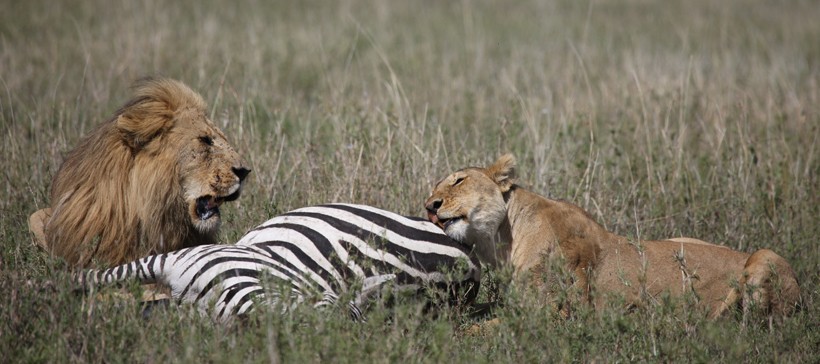
Male and female lion feeding on a zebra
?
Image credits: Valerijs Novickis/Shutterstock
As soon as the prey goes down, the male(s) make an entrance. Males get the opportunity to eat first, followed by the females and their cubs. The dominant male lions of the pride participate in hunting when the prey is too large to handle. When the food gets scarce in the dry grasslands, lions can go after any mammal they spot. They have been sighted killing large animals like giraffes, hippos, and even elephants on rare occasions. The lions seem to have a different strategy for such conditions. In the hot conditions of Africa, large mammals are forced to migrate in search of water. The lions use this opportunity and try to exhaust the prey by keeping it engaged for a while. Once the giant gets slow, the entire pride, along with large and strong males, use their brute strength to bring the animal down.
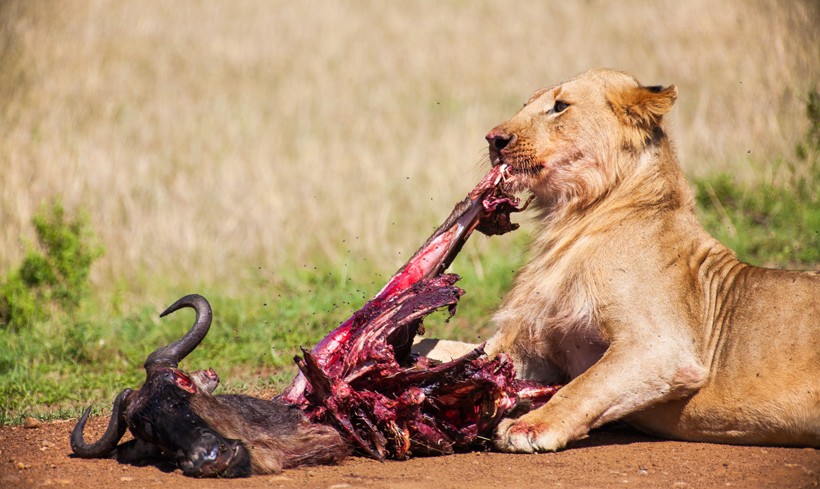
Lioness feeding on a wildebeest carcass
?
Image credits: StanislavBeloglazov/Shutterstock
Life is not easy for lions due to the harshness of its habitat. Only 20% of their attempts turn into successful hunts. And every hunt in the dry savannah attracts many scavengers. In fact, every predator in lion habitat is also an efficient scavenger, and the lion is the strongest of them all. But the spotted hyenas of Africa prove to be more efficient in scavenging. A clan of hyenas can have up to 90 individuals and their bite is stronger than that of lions. A large clan of hyenas can easily overpower a pride and force them to retreat from their kill. Hyenas and lions are archrivals in Africa. While lions don’t hesitate to kill wandering hyenas, the hyenas are also known to kill lions if they find them in a vulnerable state.
As lions tend to hunt large mammals as well, they face a serious threat of getting injured during the hunt. Large prey like elephants and giraffes can turn into brutal killers when their young are under threat. But no animal is more brutal than a herd of panicked African water buffaloes. They are huge, approximately 700 kg of weight and a herd can have up to 300 animals. When one of them is in trouble, it sends out a distress call which is irresistible for the rest of the herd. The entire herd unites and charges towards the threat. If the lions fail to retreat quickly, they can get killed. African water buffaloes sometimes charge at the lions without any threat of being hunted; they have been sighted killing lion cubs too. Such incidents clearly indicate a higher level of rivalry between the two species than the usual prey-predator conflict.
Thus, despite being at the top of the food chain, the lions live an unforgiving lifestyle, surrounded by several threats within their habitat.
Reproduction and Lifecycle
Lions reach sexual maturity at the age of 2 years but mating occurs usually at the age of 4. Lions can mate at any time of the year. The females are polyestrous and there is no specific breeding season for the pride. Copulation may occur up to 100 times a day. The male’s penis has backward pointing spines that scratch the inner walls of the female’s vagina upon withdrawal causing ovulation in females. The gestation period for lions takes up to three and half months or 105 to 110 days. Before giving birth, the female moves away from rest of the pride. She finds a well-hidden place and gives birth to 3 to 7 cubs.
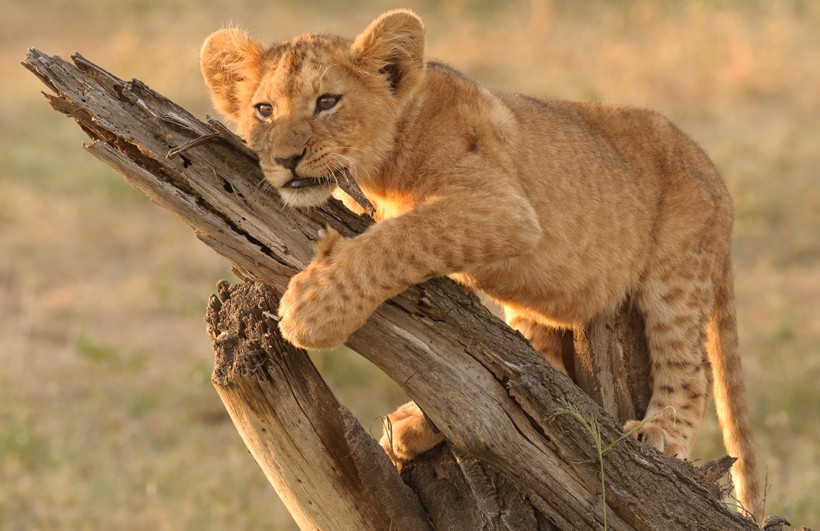
Lion cub on a log
?
Image credits: NaturesMomentsuk/Shutterstock
The cubs weigh only 1.5 kg at birth. They are kept hidden from the rest of the pride for the first couple of months. The newborn cub opens its eyes within 3 to 11 days after birth. All the females participate in parenting activities. They suckle cubs and protect them from other males of the pride. Soon after the cubs are introduced to the pride, they start eating meat. And at the age of 6 to 7 months, the cubs are weaned completely. When the females leave for hunting, the cubs are left under the protection of the male lion.
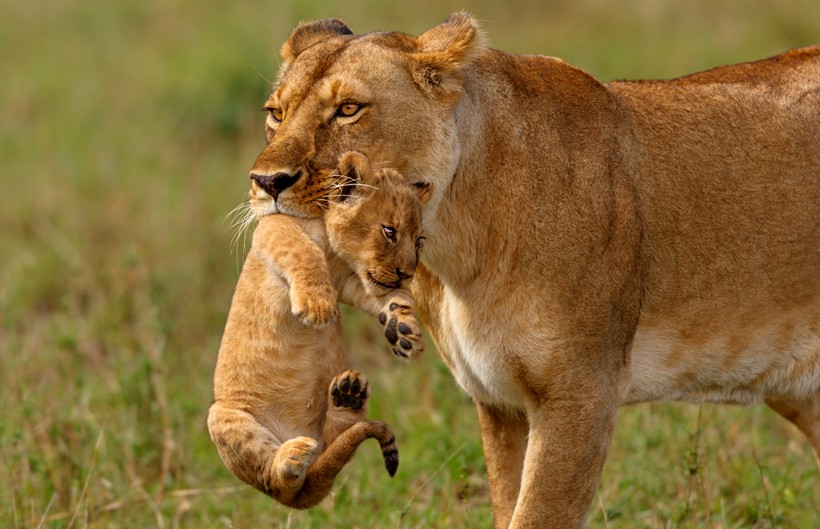
Lioness mother carries the newborn cub in her mouth
?
Image credits: Maggy Meyer/Shutterstock
The lion cubs have a very low rate of survival with the biggest threat being male lions. When a nomad male takes over a pride, it kills all the cubs first. This is done so that the females get back in estrus and the new male can spread his genes as quickly as possible. When males challenge each other, the fights can be brutal and fatal. The loser can get killed and if not, he has to retreat and move away as far as possible from the pride.
At the age of 2 years, when the cubs reach sexual maturity, the juvenile males are forced to move out of the pride while the females stay in the same pride for their lifetime. The nomad males may spend up to 2 years in search of a pride. At the age of 4, a male lion has only 2 to 3 years more, to mate and raise his cubs before he finally gets old and vulnerable to young nomad lions.
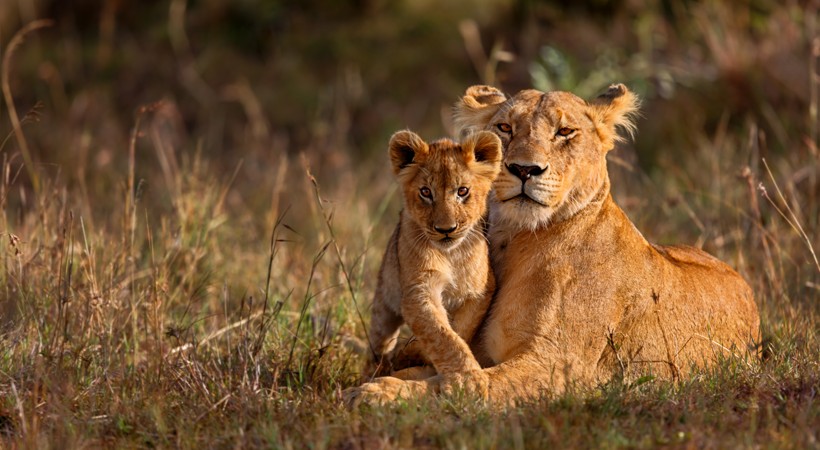
Lioness resting with cub in the sunset, Kenya
?
Image credits: Maggy Meyer/Shutterstock
Lions are known to form hybrids with tigers, leopards and jaguars, but most cannot survive in the wild as males are often infertile. The hybrid between a male lion and a tigress is called the liger and that between a lioness and tiger is known as tigon.
The liger grows larger than both the parent species while the tigon is smaller compared to its parents. Hybrids of lions with leopards and jaguars are named as liguar, jaglion, lipard and leopon. In most cases, the offspring displays mixed physical characteristics of both the parent species.
Communication and Intelligence
Unlike other cats, a lot of communication is observed amongst lions, which can be the result of their social lifestyle. Lions make a wide range of vocal calls and physical gestures in order to communicate with other lions. Roars, growls, moans, purrs, grunts, hums and woofs are some of the most common sounds made by the lions. The lion can pitch its sound at several different volumes and tones, enabling it to get the message far and clear to all surrounding lions. Vocalizations are more frequent when males sense each other. They use loud roars to display territorial ownership and to intimidate rival males. These loud roars can be heard from a distance of several miles while low range vocal calls are used to communicate within the pride.
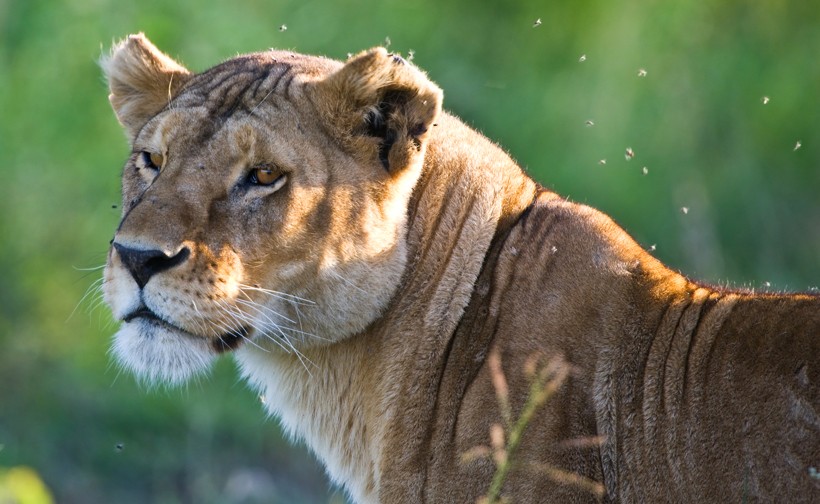
Closeup head lioness, Tanzania
?
Image credits: Travel Stock/Shutterstock
Lions are also known to mark their territory by urinating and scratching the paws on a tree bark. These scents act as a clear message for any animal that they are entering the lion territory. The elaborate communication system, adaptive hunting strategies and complex social behaviors, clearly indicate that lions are remarkably intelligent predators. Their own intelligence and problem-solving abilities are the prime factors why lions could be tamed and used since the ancient times.
Population and Conservation
The lion population is under tremendous threat of extinction. Once found in large numbers throughout Africa and Asia, they now survive only in the grasslands of Africa and Western India. All the surviving subspecies face threats like hunting and loss of habitat. The Asiatic lions found in India, inhabit a very small range in the western state of Gujarat. They are found only in and around the Gir National Park in India. Only 411 Asiatic lions remained in Gujarat by the end of the year 2010. Since then, the population has recovered due to effective conservation of lion habitat. Several protected areas have formed in Gujarat to support the Asiatic lion populations. A survey held in May 2015 reported that there are over 520 Asiatic lions in Gujarat. Due to this increase in number, the government in India has taken steps to reintroduce the Asiatic lions to other states of India.
All the subspecies found in Africa share a similar fate, if not worse. Excessive poaching and loss of habitat are decreasing the population number at a high rate. Governments have set up several national parks and game reserves in order to conserve the population of African Lions. Some of the most famous parks are the Kruger National Park, Serengeti National Park and Etosha National Park. These protected areas are established with the purpose of keeping humans away from the lions.
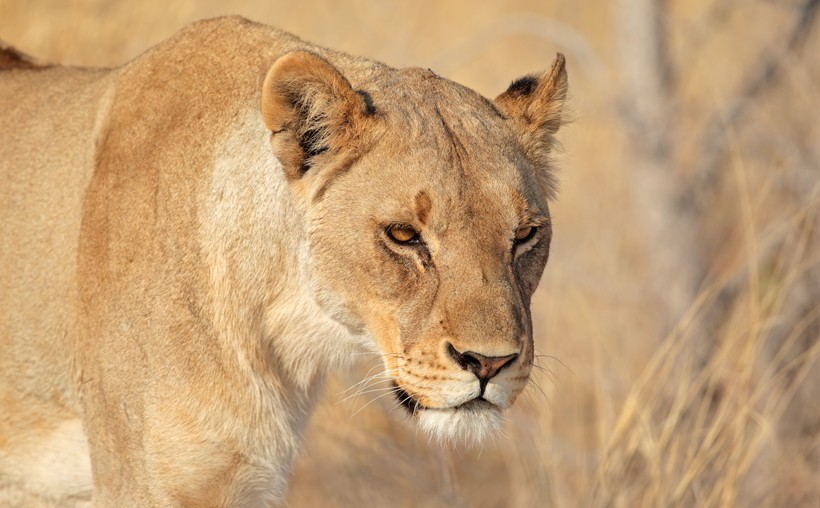
Lions have the status Vulnerable on the IUCN Red List
?
Image credits: EcoPrint/Shutterstock
Due to the increase of the human population, lion habitats are being reduced rapidly, causing loss of prey and territory. This results in an array of problems for the lions. With the loss of habitat, lion prides are forced to live close to each other, resulting in frequent clashes between neighboring prides and causing death of newborn cubs. Large coalitions of males and unusually large prides are formed under extreme circumstances. Deforestation and cultivation in lion habitat also cause loss of prey for the lions. With human settlements invading its territory at a rapid rate, the lions have a tendency to turn into man-eaters. Due to attacks on humans, locals see the lions with fear and hatred. Man-eating lions are hunted down or captured, for the safety of the locals. Poaching and illegal trade are also one of the primary causes for the population drop of lions. The recent surveys state that there are only 17,000 to 20,000 African lions and 500 to 600 Asiatic lions remaining in the wild, and the numbers are dropping.
Despite attacks on humans, lions have gained respect amongst humans since the ancient times. Lions can be seen appearing in several cultures throughout Eurasia and Africa. The lion has been used as a symbol of royalty and bravery by many tribes and dynasties over the course of time. Romans, Greeks Indians and Africans have depicted majestic lions to display the greatness of their empires. Ancient carvings, statues, coins and paintings of lions have also been discovered on various historical sites of Asia, Europe, and Africa.
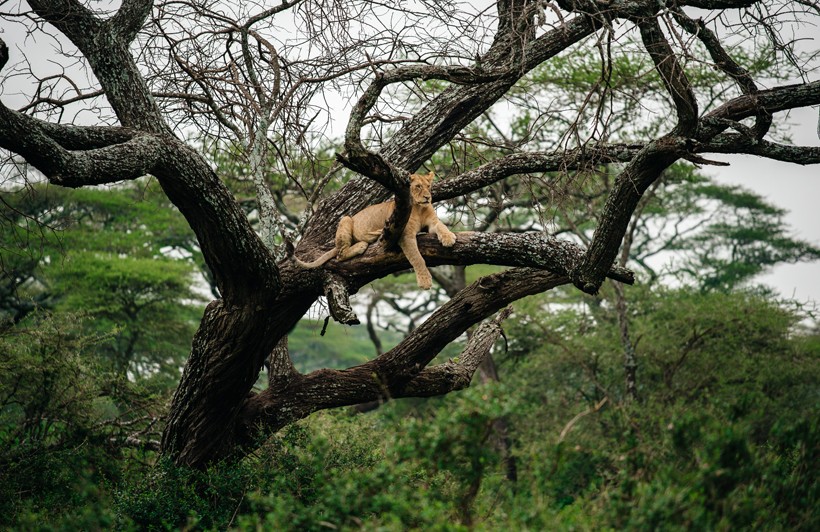
Lioness climbing in a tree
?
Image credits: costas anton dumitrescu/Shutterstock
Note:
Lions are Apex Predators, which means they are on top of the food chain and play a very important role in the ecosystem of its habitat. The lion is the only predator of large mammals like buffaloes, Nilgais, and wildebeests. By preying on such large species, the lions keep the forest vegetation in good condition. They also keep the herbivorous herds on the move, not allowing them to feed on one place for too long intervals of time. If lions become extinct, the large herbivores will have no natural predators left. This can give way to problems like population outburst and overgrazing, which can be extremely harmful to the entire ecosystem. If this King of the Jungle falls, the entire ecosystem and several other creatures will also fall. Hence, conservation of lions is extremely important for the survival of living beings on this planet.
Evolution
The species P. leo came into existence between 1.8 million to 500,000 years ago. The species evolved in Africa from small-sized ancestors that were much like the mongoose. From fossil evidence it is concluded the ancestor to all cats existed approximately 55 million years ago. The species named Dormaalocyon latouri is considered to be the ancestor of all lions, tigers and bears. This arboreal mongoose-like creature was very small compared to its modern descendants.
After several million years of evolution, the species P. leo evolved in Africa from its smaller ancestors. Between 800,000 and 100,000 years ago, the lions migrated out of Africa and inhabited Eurasia. The earliest fossil of P. leo in Europe is estimated to be up to 700,000 years old. Approximately 300,000 years ago the cave lions evolved from the early lions in Europe. However, these large lions couldn’t survive the last glaciations, and were extinct from Eurasia, 10,000 years ago. The group living lions survived and formed the modern population of lions.
Funfacts
- Panthera leo or Lion is also known as the King of the Jungle and their group is known as the Pride.
- Unlike other big cats, lions display clearly visible sexual dimorphism.
- Lions are the only cats that live in groups.
- The tiger is larger than a lion, but as lions live in groups, they are capable of hunting even larger animals.
- When a nomad lion takes over a pride, he kills all the cubs so that he can mate with the females.
- Bachelor male lions can form coalitions, which can have up to 4 large male lions. Coalitions are often formed by blood brothers.
- A lion’s roar can be heard at a distance of several kilometers.
- Lions have no definite breeding season and a female can copulate over 100 times in a day when she is in heat.
- The nominate subspecies P. l. leo, the Barbary lion was the largest amongst all subspecies. It is currently extinct in the wild.
- The Tsavo lions are seen as instinctual man-eaters, especially after the incident where over 100 workers were killed by two Tsavo lions.
- The Asiatic lions, which were found in large numbers in central, southern and western Asia in former days, are found today only in The Gir forest range of India, which has an area of only 1412 sq km.
- Just close to 20,000 lions are remaining in the wild today; their population numbers are dropping rapidly.
